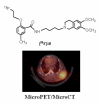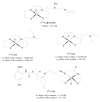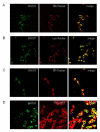Development of molecular probes for imaging sigma-2 receptors in vitro and in vivo
- PMID: 20021357
- PMCID: PMC2802455
- DOI: 10.2174/1871524910909030230
Development of molecular probes for imaging sigma-2 receptors in vitro and in vivo
Abstract
The sigma-2 (sigma(2)) receptor is proving to be an important protein in the field of cancer biology. The observations that sigma(2) receptors have a 10-fold higher density in proliferating tumor cells than in quiescent tumor cells, and that sigma(2) receptor agonists are capable of killing tumor cells via apoptotic and non-apoptotic mechanisms, indicate that this receptor is an important molecular target for the development of radiotracers for imaging tumors using techniques such as Positron Emission Tomography (PET) and Single Photon Emission Computed Tomography (SPECT) and for the development of cancer chemotherapeutic agents. In spite of recent promising results towards achieving these goals, research in this field has been hampered by the fact that the molecular identity of the protein sequence of the sigma(2) receptor is currently not known. Consequently, most of what is known about this protein has been obtained using either radiolabeled or fluorescent probes for this receptor, or biochemical analysis of the effect of sigma(2) selective ligands on cells growing under tissue culture conditions. This article provides a review of the development and use of sigma(2) receptor ligands, and how these ligands have been used with a variety of in vitro and in vivo models to gain a greater understanding of the role this receptor plays in cancer.
Figures














Similar articles
-
Molecular Probes for Imaging the Sigma-2 Receptor: In Vitro and In Vivo Imaging Studies.Handb Exp Pharmacol. 2017;244:309-330. doi: 10.1007/164_2016_96. Handb Exp Pharmacol. 2017. PMID: 28176045 Review.
-
Sigma receptors in oncology: therapeutic and diagnostic applications of sigma ligands.Curr Pharm Des. 2010;16(31):3519-37. doi: 10.2174/138161210793563365. Curr Pharm Des. 2010. PMID: 21050178 Review.
-
Current development of sigma-2 receptor radioligands as potential tumor imaging agents.Bioorg Chem. 2021 Oct;115:105163. doi: 10.1016/j.bioorg.2021.105163. Epub 2021 Jul 13. Bioorg Chem. 2021. PMID: 34289426 Review.
-
The σ2 receptor: a novel protein for the imaging and treatment of cancer.J Med Chem. 2013 Sep 26;56(18):7137-60. doi: 10.1021/jm301545c. Epub 2013 Jun 18. J Med Chem. 2013. PMID: 23734634 Free PMC article. Review.
-
Imaging sigma receptors: applications in drug development.Curr Pharm Des. 2007;13(1):51-72. doi: 10.2174/138161207779313740. Curr Pharm Des. 2007. PMID: 17266588 Review.
Cited by
-
Synthesis and characterization of N,N-dialkyl and N-alkyl-N-aralkyl fenpropimorph-derived compounds as high affinity ligands for sigma receptors.Bioorg Med Chem. 2010 Jun 15;18(12):4397-404. doi: 10.1016/j.bmc.2010.04.078. Epub 2010 Apr 29. Bioorg Med Chem. 2010. PMID: 20493718 Free PMC article.
-
Sigma-2 Receptors-From Basic Biology to Therapeutic Target: A Focus on Age-Related Degenerative Diseases.Int J Mol Sci. 2023 Mar 26;24(7):6251. doi: 10.3390/ijms24076251. Int J Mol Sci. 2023. PMID: 37047224 Free PMC article. Review.
-
The novel drug candidate S2/IAPinh improves survival in models of pancreatic and ovarian cancer.Sci Rep. 2024 Mar 16;14(1):6373. doi: 10.1038/s41598-024-56928-z. Sci Rep. 2024. PMID: 38493257 Free PMC article.
-
Synthesis of σ Receptor Ligands with a Spirocyclic System Connected with a Tetrahydroisoquinoline Moiety via Different Linkers.ChemMedChem. 2021 Apr 8;16(7):1184-1197. doi: 10.1002/cmdc.202000861. Epub 2021 Feb 2. ChemMedChem. 2021. PMID: 33332704 Free PMC article.
-
Synthesis and structure-activity relationship studies of conformationally flexible tetrahydroisoquinolinyl triazole carboxamide and triazole substituted benzamide analogues as σ2 receptor ligands.J Med Chem. 2014 May 22;57(10):4239-51. doi: 10.1021/jm5001453. Epub 2014 May 12. J Med Chem. 2014. PMID: 24821398 Free PMC article.
References
-
- Walker JM, Bowen WD, Walker FO, Matsumoto RR, De Costa B, Rice KC. Sigma receptors: biology and function. Pharmacol. Rev. 1990;42:355–402. - PubMed
-
- Hellewell SB, Bruce A, Feinstein G, Orringer J, Williams W, Bowen WD. Rat liver and kidney contain high densities of sigma-1 and sigma-2 receptors: characterization by ligand binding and photoaffinity labeling. Eur. J. Pharmacol. Mol. Pharmacol. Sec. 1994;268:9–18. - PubMed
-
- Maurice T, Roman FJ, Privat A. Modulation by neurosteroids of the in vivo (+)-[3H]SKF-10,047 binding to sigma-1 receptors in the mouse forebrain. J. Neurosci. Res. 1996;46:734–743. - PubMed
-
- Maurice T, Junien J-L, Privat A. Dehydroepiandrosterone sulfate attenuates dizocilpine-induced learning impairment in mice via sigma-1-receptors. Behavioural Brain Research. 1997;83:159–164. - PubMed
Publication types
MeSH terms
Substances
Grants and funding
LinkOut - more resources
Full Text Sources
